Crystal Violet Adsorption on Eco-Friendly Lignocellulosic Material Obtained from Motherwort (Leonurus cardiaca L.) Biomass
Abstract
1. Introduction
2. Materials and Methods
3. Results and Discussion
3.1. Adsorbent Characterization
3.1.1. FTIR Analysis
3.1.2. Point of Zero Charge (pHPZC) Determination
3.1.3. SEM Analysis
3.1.4. Color Analysis
3.2. Equilibrium Isotherms
3.3. Kinetic Models
3.4. Thermodynamic Study
3.5. Influence of the pH Solution on Adsorption Capacity
3.6. Influence of Ionic Strength on Adsorption Capacity
3.7. Influence of Adsorbent Dose on Adsorption Capacity
3.8. Optimization Using the Taguchi Method
3.9. Desorption Study
4. Conclusions
Supplementary Materials
Author Contributions
Funding
Institutional Review Board Statement
Informed Consent Statement
Data Availability Statement
Conflicts of Interest
References
- Homagai, P.L.; Poudel, R.; Poudel, S.; Bhattarai, A. Adsorption and removal of crystal violet dye from aqueous solution by modified rice husk. Heliyon 2022, 8, e09261. [Google Scholar] [CrossRef] [PubMed]
- Rápó, E.; Tonk, S. Factors Affecting Synthetic Dye Adsorption; Desorption Studies: A Review of Results from the Last Five Years (2017–2021). Molecules 2021, 26, 5419. [Google Scholar] [CrossRef] [PubMed]
- Nieva, A.D.; Avena, L.G.S.; Pascual, M.A.M.; Pamintuan, K.R.S. Characterization of Powdered Pineapple (Ananas comosus) Crown Leaves as Adsorbent for Crystal Violet in Aqueous Solutions. IOP Conf. Ser. Earth Environ. Sci. 2020, 563, 012010. [Google Scholar] [CrossRef]
- Zamouche, M.; Habib, A.; Saaidia, K.; Lehocine, M.B. Batch mode for adsorption of crystal violet by cedar cone forest waste. SN Appl. Sci. 2020, 2, 198. [Google Scholar] [CrossRef]
- Abbasi, F.; Tavakkoli Yaraki, M.; Farrokhnia, A.; Bamdad, M. Keratin nanoparticles obtained from human hair for removal of crystal violet from aqueous solution: Optimized by Taguchi method. Int. J. Biol. Macromol. 2020, 143, 492–500. [Google Scholar] [CrossRef]
- Foroutan, R.; Peighambardoust, S.J.; Peighambardoust, S.H.; Pateiro, M.; Lorenzo, J.M. Adsorption of Crystal Violet Dye Using Activated Carbon of Lemon Wood and Activated Carbon/Fe3O4 Magnetic Nanocomposite from Aqueous Solutions: A Kinetic, Equilibrium and Thermodynamic Study. Molecules 2021, 26, 2241. [Google Scholar] [CrossRef]
- Franco, D.S.P.; Georgin, J.; Drumm, F.C.; Netto, M.S.; Allasia, D.; Oliveira, M.L.S.; Dotto, G.L. Araticum (Annona crassiflora) seed powder (ASP) for the treatment of colored effluents by biosorption. Environ. Sci. Pollut. Res. 2020, 27, 11184–11194. [Google Scholar] [CrossRef]
- Franco, D.S.P.; Fagundes, J.L.S.; Georgin, J.; Salaua, N.P.G.; Dotto, G.L. A mass transfer study considering intraparticle diffusion and axial dispersion for fixed-bed adsorption of crystal violet on pecan pericarp (Carya illinoensis). Chem. Eng. J. 2020, 397, 125423. [Google Scholar] [CrossRef]
- Shakoor, S.; Nasar, A. Adsorptive decontamination of synthetic wastewater containing crystal violet dye by employing Terminalia arjuna sawdust waste. Groundw. Sustain. Dev. 2018, 7, 30–38. [Google Scholar] [CrossRef]
- Chahinez, H.O.; Abdelkader, O.; Leila, Y.; Tran, H.N. One-stage preparation of palm petiole-derived biochar: Characterization and application for adsorption of crystal violet dye in water. Environ. Technol. Innov. 2020, 19, 100872. [Google Scholar] [CrossRef]
- Chakraborty, S.; Chowdhury, S.; Das, P. Insight into biosorption equilibrium, kinetics and thermodynamics of crystal violet onto Ananas comosus (pineapple) leaf powder. Appl. Water Sci. 2012, 2, 135–141. [Google Scholar] [CrossRef][Green Version]
- El-Sayed, G.O. Removal of methylene blue and crystal violet from aqueous solutions by palm kernel fiber. Desalination 2011, 272, 225–232. [Google Scholar] [CrossRef]
- Georgin, J.; Marques, B.S.; Peres, E.C.; Allasia, D.; Dotto, G.L. Biosorption of cationic dyes by Pará chestnut husk (Bertholletia excelsa). Water Sci. Technol. 2018, 77, 1612–1621. [Google Scholar] [CrossRef]
- Kosar Hashemi, Y.; Tavakkoli Yaraki, M.; Ghanbari, S.; Heidarpoor Saremi, L.; Givianrad, M.H. Photodegradation of organic water pollutants under visible light using anatase F, N co-doped TiO2/SiO2 nanocomposite: Semi-pilot plant experiment and density functional theory calculations. Chemosphere 2021, 275, 129903. [Google Scholar] [CrossRef]
- Pang, X.; Sellaoui, L.; Franco, D.; Dotto, G.L.; Georgin, J.; Bajahzar, A.; Belmabrouk, H.; Ben Lamine, A.; Bonilla-Petriciolet, A.; Lia, Z. Adsorption of crystal violet on biomasses from pecan nutshell, para chestnut husk, araucaria bark and palm cactus: Experimental study and theoretical modeling via monolayer and double layer statistical physics models. Chem. Eng. J. 2019, 378, 122101. [Google Scholar] [CrossRef]
- Pang, X.; Sellaoui, L.; Franco, D.; Netto, M.S.; Georgin, J.; Dotto, G.L.; Abu Shayeb, M.K.; Belmabrouk, H.; Bonilla-Petriciolet, A.; Li, Z. Preparation and characterization of a novel mountain soursop seeds powder adsorbent and its application for the removal of crystal violet and methylene blue from aqueous solutions. Chem. Eng. J. 2020, 391, 123617. [Google Scholar] [CrossRef]
- Chowdhury, S.; Chakraborty, S.; Das, P. Removal of Crystal Violet from Aqueous Solution by Adsorption onto Eggshells: Equilibrium, Kinetics, Thermodynamics and Artificial Neural Network Modeling. Waste Biomass-Valorization 2012, 4, 655–664. [Google Scholar] [CrossRef]
- Dotto, G.L.; McKay, G. Current scenario and challenges in adsorption for water treatment. J. Environ. Chem. Eng. 2020, 8, 103988. [Google Scholar] [CrossRef]
- Georgin, J.; Franco, D.S.P.; Netto, M.S.; Allasia, D.; Oliveira, M.L.S.; Dotto, G.L. Evaluation of Ocotea puberula bark powder (OPBP) as an effective adsorbent to uptake crystal violet from colored effluents: Alternative kinetic approaches. Environ. Sci. Pollut. Res. 2020, 27, 25727–25739. [Google Scholar] [CrossRef]
- Loulidi, I.; Boukhlifi, F.; Ouchabi, M.; Amar, A.; Jabri, M.; Kali, A.; Chraibi, S.; Hadey, C.; Aziz, F. Adsorption of Crystal Violet onto an Agricultural Waste Residue: Kinetics, Isotherm, Thermodynamics, and Mechanism of Adsorption. Sci. World. J. 2020, 2020, 1–9. [Google Scholar] [CrossRef]
- Zehra, T.; Priyantha, N.; Lim, L.B.L. Removal of crystal violet dye from aqueous solution using yeast-treated peat as adsorbent: Thermodynamics, kinetics, and equilibrium studies. Environ. Earth Sci. 2016, 75, 375. [Google Scholar] [CrossRef]
- Bharathi, K.S.; Ramesh, S.T. Biosorption of crystal violet from aqueous solution by Citrullus lanatus rind. J. Environ. Res. Dev. 2012, 7, 321–329. [Google Scholar]
- Keereerak, A.; Chinpa, W. A potential biosorbent from Moringa oleifera pod husk for crystal violet adsorption: Kinetics, isotherms, thermodynamic and desorption studies. Sci. Asia 2020, 46, 186–194. [Google Scholar] [CrossRef]
- Kulkarni, M.R.; Revanth, T.; Acharya, A.; Bhat, P. Removal of Crystal Violet dye from aqueous solution using water hyacinth: Equilibrium, kinetics and thermodynamics study. Resour. Technol. 2017, 3, 71–77. [Google Scholar] [CrossRef]
- Pavan, F.A.; Camacho, E.S.; Lima, E.C.; Dotto, G.L.; Branco, V.T.; Dias, S. Formosa papaya seed powder (FPSP): Preparation, characterization and application as an alternative adsorbent for the removal of crystal violet from aqueous phase. J. Environ. Chem. Eng. 2014, 2, 230–238. [Google Scholar] [CrossRef]
- Bulgariu, L.; Escudero, L.B.; Bello, O.S.; Iqbal, M.; Nisar, J.; Adegoke, K.A.; Alakhras, F.; Kornaros, M.; Anastopoulos, I. The utilization of leaf-based adsorbents for dyes removal: A review. J. Mol. Liq. 2019, 276, 728–747. [Google Scholar] [CrossRef]
- Silveira, M.B.; Pavan, F.A.; Gelos, N.F.; Lima, E.C.; Dias, S.L. Punica granatum shell preparation, characterization, and use for crystal violet removal from aqueous solution. CLEAN-Soil Air Water 2014, 42, 939–946. [Google Scholar] [CrossRef]
- Chevallier, A. Encyclopedia of Herbal Medicine: 550 Herbs and Remedies for Common Ailments, 3rd ed.; DK Publishing: New York, NY, USA, 2016; p. 227. [Google Scholar]
- Bernatoniene, J.; Kopustinskiene, D.M.; Jakstas, V.; Majiene, D.; Baniene, R.; Kuršvietiene, L.; Masteikova, R.; Savickas, A.; Toleikis, A.; Trumbeckaite, S. The Effect of Leonurus cardiaca Herb Extract and Some of its Flavonoids on Mitochondrial Oxidative Phosphorylation in the Heart. Planta Med. 2014, 80, 525–532. [Google Scholar] [CrossRef]
- Angeloni, S.; Spinozzi, E.; Maggi, F.; Sagratini, G.; Caprioli, G.; Borsetta, G.; Ak, G.; Sinan, K.I.; Zengin, G.; Arpini, S.; et al. Phytochemical Profile and Biological Activities of Crude and Purified Leonurus cardiaca Extracts. Plants 2021, 10, 195. [Google Scholar] [CrossRef]
- Kushwaha, A.K.; Gupta, N.; Chattopadhyaya, M.C. Removal of cationic methylene blue and malachite green dyes from aqueous solution by waste materials of Daucus carota. J. Saudi Chem. Soc. 2014, 18, 200–207. [Google Scholar] [CrossRef]
- Piccin, J.S.; Cadaval, T.R.S.; de Pinto, L.A.A.; Dotto, G.L. Adsorption Isotherms in Liquid Phase: Experimental, Modeling, and Interpretations. In Adsorption Processes for Water Treatment and Purification; Bonilla-Petriciolet, A., Mendoza-Castillo, D., Reynel-Avila, H., Eds.; Springer: Cham, Switzerland, 2017; pp. 19–51. [Google Scholar]
- Dotto, G.L.; Salau, N.P.G.; Piccin, J.S.; Cadaval, T.R.S.; de Pinto, L.A.A. Adsorption Kinetics in Liquid Phase: Modeling for Discontinuous and Continuous Systems. In Adsorption Processes for Water Treatment and Purification; Bonilla-Petriciolet, A., Mendoza-Castillo, D., Reynel-Avila, H., Eds.; Springer: Cham, Switzerland, 2017; pp. 53–76. [Google Scholar]
- Filho, A.C.D.; Mazzocato, A.C.; Dotto, G.L.; Thue, P.S.; Pavan, F.A. Eragrostis plana Nees as a novel eco-friendly adsorbent for removal of crystal violet from aqueous solutions. Environ. Sci. Pollut. Res. 2017, 24, 19909–19919. [Google Scholar] [CrossRef] [PubMed]
- Esteves, B.; Velez Marques, A.; Domingos, I.; Pereira, H. Chemical changes of heat treated pine and eucalypt wood monitored by FTIR. Maderas-Cienc. Tecnol. 2013, 15, 245–258. [Google Scholar] [CrossRef]
- Moosavinejad, S.M.; Madhoushi, M.; Vakili, M.; Rasouli, D. Evaluation of degradation in chemical compounds of wood in historical buildings using FT-IR and FT-RAMAN vibrational spectroscopy. Maderas-Cienc. Tecnol. 2019, 21, 381–392. [Google Scholar] [CrossRef]
- Sanches, N.B.; Cassu, S.N.; Dutra, R.d.C.L. TG/FT-IR characterization of additives typically employed in EPDM formulations. Polimeros 2015, 25, 247–255. [Google Scholar] [CrossRef]
- Ruiz, H.A.; Ruzene, D.S.; Silva, D.P.; Macieira da Silva, F.F.; Vicente, A.A.; Teixeira, J.A. Development and Characterization of an Environmentally Friendly Process Sequence (Autohydrolysis and Organosolv) for Wheat Straw Delignification. Appl. Biochem. Biotechnol. 2011, 164, 629–641. [Google Scholar] [CrossRef]
- Lv, P.; Almeida, G.; Perre, P. TGA-FTIR Analysis of Torrefaction of Lignocellulosic Components (cellulose, xylan, lignin) in Isothermal Conditions over a Wide Range of Time Durations. BioResources 2015, 10, 4239–4251. [Google Scholar] [CrossRef]
- Li, X.; Wei, Y.; Xu, J.; Xu, N.; He, Y. Quantitative visualization of lignocellulose components in transverse sections of moso bamboo based on FTIR macro- and micro-spectroscopy coupled with chemometrics. Biotechnol. Biofuels 2018, 11, 263. [Google Scholar] [CrossRef]
- Munene, J.M.; Onyatta, J.O.; Yusuf, A.O. Characterization of Water Hyacinth Powder Using FTIR Spectroscopy and the Adsorption Behaviour of Pb2+, Cd2+, Zn2+, Ni2+ and Cr2+ in Aqueous Solution. Asian J. Appl. Chem. Res. 2020, 6, 47–55. [Google Scholar] [CrossRef]
- Weng, C.H.; Lin, Y.T.; Tzeng, T.W. Removal of methylene blue from aqueous solution by adsorption onto pineapple leaf powder. J. Hazard. Mater. 2009, 170, 417–424. [Google Scholar] [CrossRef]
- Meisam, T.M. Biosorption of lanthanum and cerium from aqueous solutions using tangerine (Citrus reticulata) peel: Equilibrium, kinetic, and thermodynamic studies. Chem. Ind. Chem. Eng. Q. 2013, 19, 79–88. [Google Scholar]
- Ali, H.; Muhammad, S.K. Biosorption of Crystal Violet from Water on Leaf Biomass of Calotropis procera. J. Environ. Sci. Technol. 2008, 1, 143–150. [Google Scholar] [CrossRef]
- Alsenani, G. Studies on adsorption of crystal violet dye from aqueous solution onto Calligonum comosum leaf powder (CCLP). J. Am. Sci. 2013, 9, 30–35. [Google Scholar]
- Muhammad, U.L.; Zango, Z.U.; Kadir, H.A.; Usman, A. Crystal violet removal from aqueous solution using corn stalk bio-sorbent. Sci. World J. 2019, 14, 133–138. [Google Scholar]
- Gemici, B.T.; Ozel, H.U.; Ozel, H.B. Adsorption behaviors of crystal violet from aqueous solution using Anatolian black pine (Pinus nigra Arnold.): Kinetic and equilibrium studies. Sep. Sci. Technol. 2020, 55, 406–414. [Google Scholar] [CrossRef]
- Karthik, K.V.S.; Sudhakar, B.; Sai Pranav, P.; Sridevi, V. Removal of Crystal Violet Dye from Aqueous Solution through Biosorption using Lysiloma Latisiliquum Seed Powder: Kinetics and Isotherms. Int. J. Eng. Res. Technol. 2019, 8, 493–497. [Google Scholar]
- Mânzatu, C.; Nagy, B.; Török, A.; Silaghi-Dumitrescu, L.; Majdik, C. Crystal violet dye biosorption and phytoextraction using living Salvinia natans and Salvinia natans powder: A comparative study. Studia Ubb Chem. 2015, 60, 289–304. [Google Scholar]
- Krika, F.; Krika, A.; Azizi, A. Arundo donax L. as a low cost and promising biosorbent for the removal of crystal violet from aqueous media: Kinetic, isotherm and thermodynamic investigations. Chem. Rev. Lett. 2019, 2, 59–68. [Google Scholar]
- Khan, F.A.; Ahad, A.; Shah, S.S.; Farooqui, M. Adsorption of crystal violet dye using Platanus orientalis (Chinar tree) leaf powder and its biochar: Equilibrium, kinetics and thermodynamics study. Int. J. Environ. Anal. Chem. 2021, 1–21. [Google Scholar] [CrossRef]
- Ahmad, R. Studies on adsorption of crystal violet dye from aqueous solution onto coniferous pinus bark powder (CPBP). J. Hazard. Mater. 2009, 171, 767–773. [Google Scholar] [CrossRef]
- Smitha, T.; Thirumalisamy, S.; Manonmani, S. Equilibrium and Kinetics Study of Adsorption of Crystal Violet onto the Peel of Cucumis sativa Fruit from Aqueous Solution. E-J. Chem. 2012, 9, 1091–1101. [Google Scholar] [CrossRef]
- Ghazali, A.; Shirani, M.; Semnania, A.; Zare-Shahabadic, V.; Nekoeiniad, M. Optimization of crystal violet adsorption onto Date palm leaves as a potent biosorbent from aqueous solutions using response surface methodology and ant colony. J. Environ. Chem. Eng. 2018, 6, 3942–3950. [Google Scholar] [CrossRef]
- Mehmood, A.; Bano, S.; Fahim, A.; Parveen, R.; Khurshid, S. Efficient removal of crystal violet and eosin B from aqueous solution using Syzygium cumini leaves: A comparative study of acidic and basic dyes on a single adsorbent. Korean J. Chem. Eng. 2015, 32, 882–895. [Google Scholar] [CrossRef]
- Das, P.; Chakraborty, S.; Chowdhury, S. Batch and continuous (fixed-bed column) biosorption of crystal violet by Artocarpus heterophyllus (jackfruit) leaf powder. Colloids Surf. B Colloid Surf. B 2012, 92, 262–270. [Google Scholar]
- Parab, H.; Sudersanan, M.; Shenoy, N.; Pathare, T.; Vaze, B. Use of Agro-Industrial Wastes for Removal of Basic Dyes from Aqueous Solutions. CLEAN–Soil Air Water 2009, 37, 963–969. [Google Scholar] [CrossRef]
- Wang, X.S.; Liu, X.; Wen, L.; Zhou, Y.; Jiang, Y.; Li, Z. Comparison of Basic Dye Crystal Violet Removal from Aqueous Solution by Low-Cost Biosorbents. Sep. Sci. Technol. 2008, 43, 3712–3731. [Google Scholar] [CrossRef]
- Lim, L.B.L.; Priyantha, N.; Mansor, N.H.M. Artocarpus altilis (breadfruit) skin as a potential low-cost biosorbent for the removal of crystal violet dye: Equilibrium, thermodynamics and kinetics studies. Environ. Earth Sci. 2014, 73, 3239–3247. [Google Scholar] [CrossRef]
- Jiang, Z.; Hu, D. Molecular mechanism of anionic dyes adsorption on cationized rice husk cellulose from agricultural wastes. J. Mol. Liq. 2018, 276, 105–114. [Google Scholar] [CrossRef]
- Zhai, Q.-Z. Studies of adsorption of crystal violet from aqueous solution by nano mesocellular foam silica: Process equilibrium, kinetic, isotherm, and thermodynamic studies. Water Sci. Technol. 2020, 81, 2092–2108. [Google Scholar] [CrossRef]
- Zaidi, N.A.H.M.; Lim, L.B.L.; Usman, A. Artocarpus odoratissimus leaf-based cellulose as adsorbent for removal of methyl violet and crystal violet dyes from aqueous solution. Cellulose 2018, 25, 3037–3049. [Google Scholar] [CrossRef]
- Fernández-López, J.A.; Angosto, J.M.; Roca, M.J.; Miñarro, M.D. Taguchi design-based enhancement of heavy metals bioremoval by agroindustrial waste biomass from artichoke. Sci. Total Environ. 2018, 653, 55–63. [Google Scholar] [CrossRef]
- Essa, W.K.; Yasin, S.A.; Abdullah, A.H.; Thalji, M.R.; Saeed, I.A.; Assiri, M.A.; Chong, K.F.; Ali, G.A.M. Taguchi L25 (54) Approach for Methylene Blue Removal by Polyethylene Terephthalate Nanofiber-Multi-Walled Carbon Nanotube Composite. Water 2022, 14, 1242. [Google Scholar] [CrossRef]
- Rahmani, M.; Kaykhaii, M.; Sasani, M. Application of Taguchi L16 design method for comparative study of ability of 3A zeolite in removal of Rhodamine B and Malachite green from environmental water samples. Spectrochim. Acta. Part A 2018, 188, 164–169. [Google Scholar] [CrossRef] [PubMed]
- Zolgharnein, J.; Rastgordani, M. Optimization of simultaneous removal of binary mixture of indigo carmine and methyl orange dyes by cobalt hydroxide nano-particles through Taguchi method. J. Mol. Liq. 2018, 262, 405–414. [Google Scholar] [CrossRef]
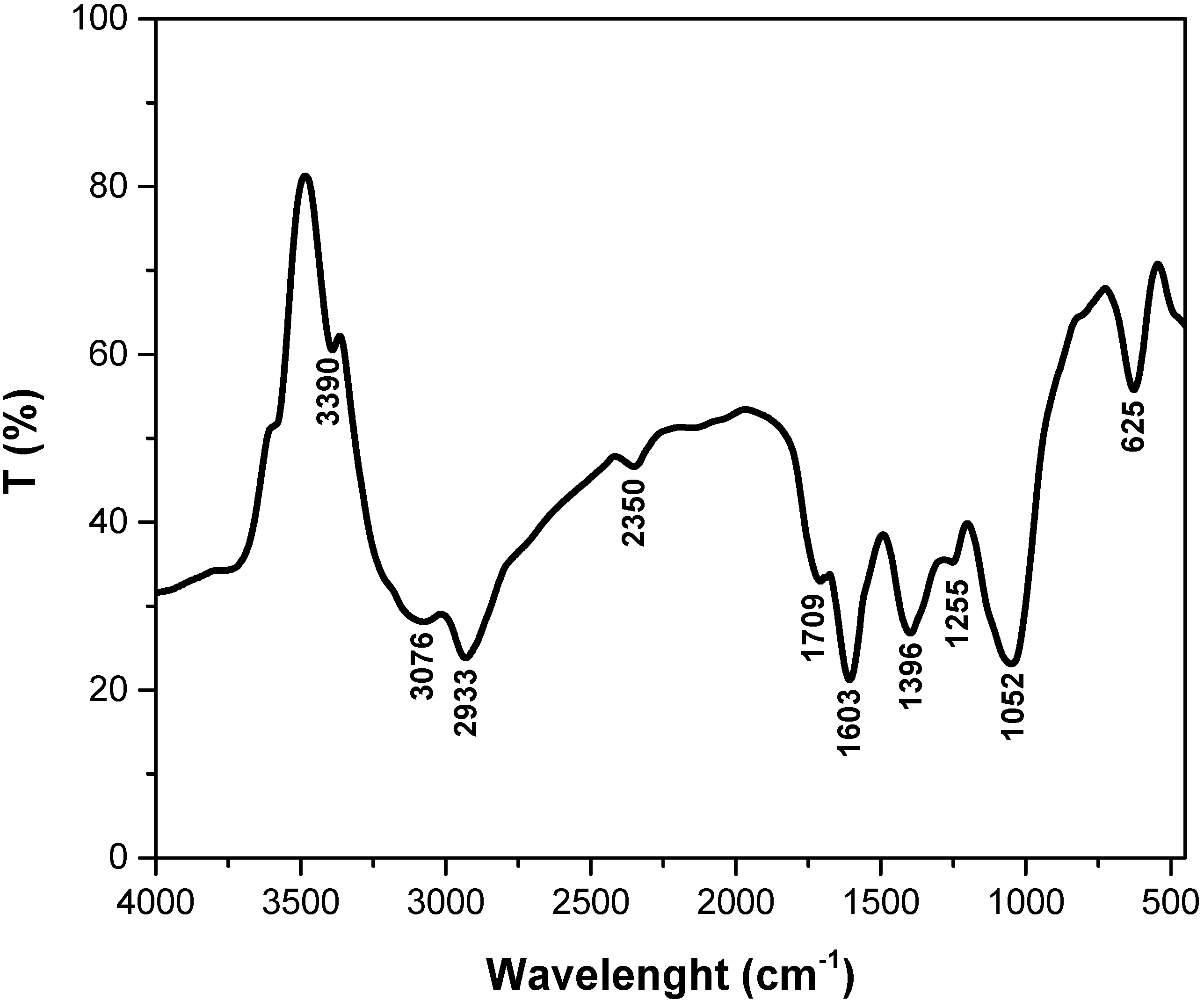
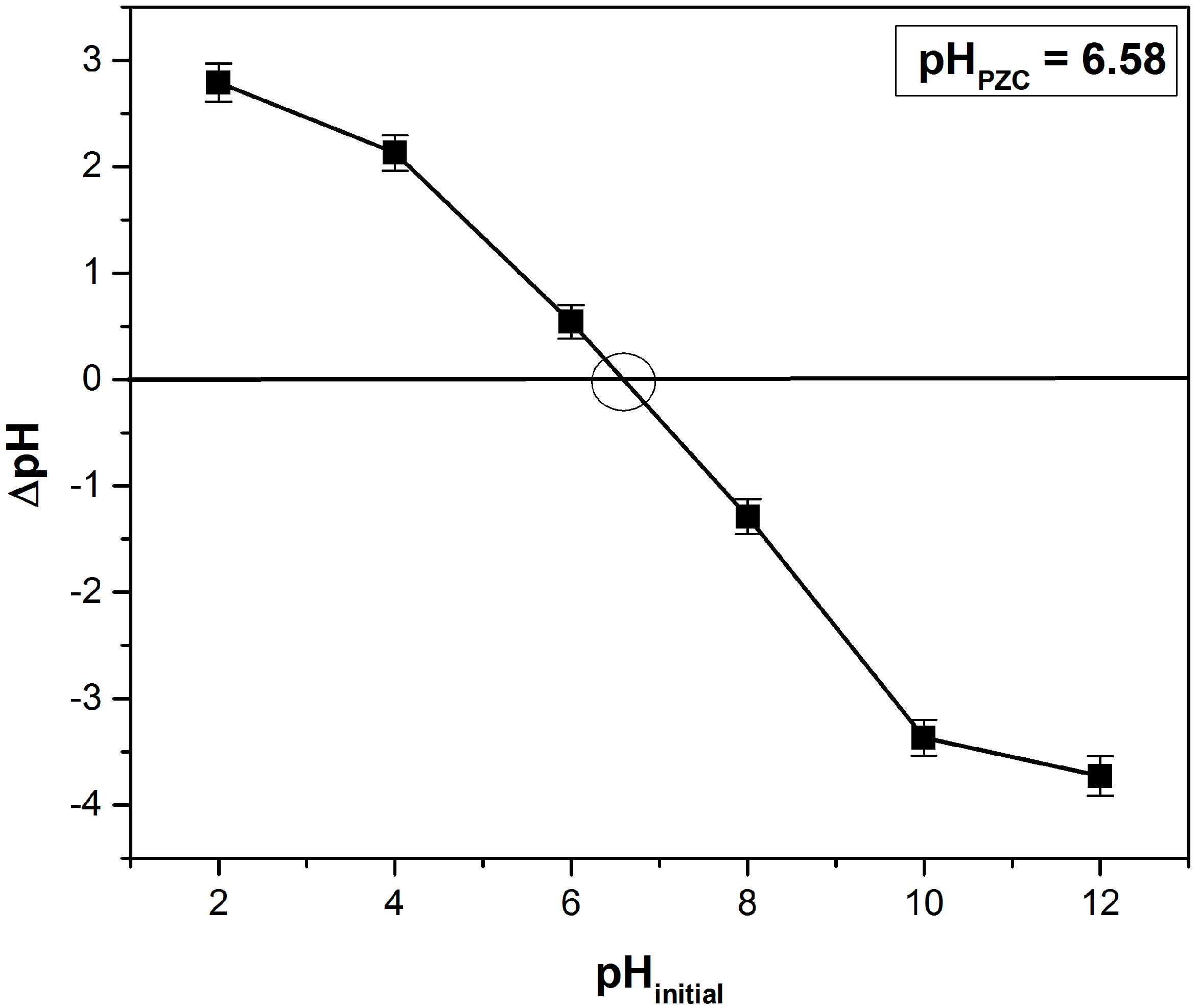
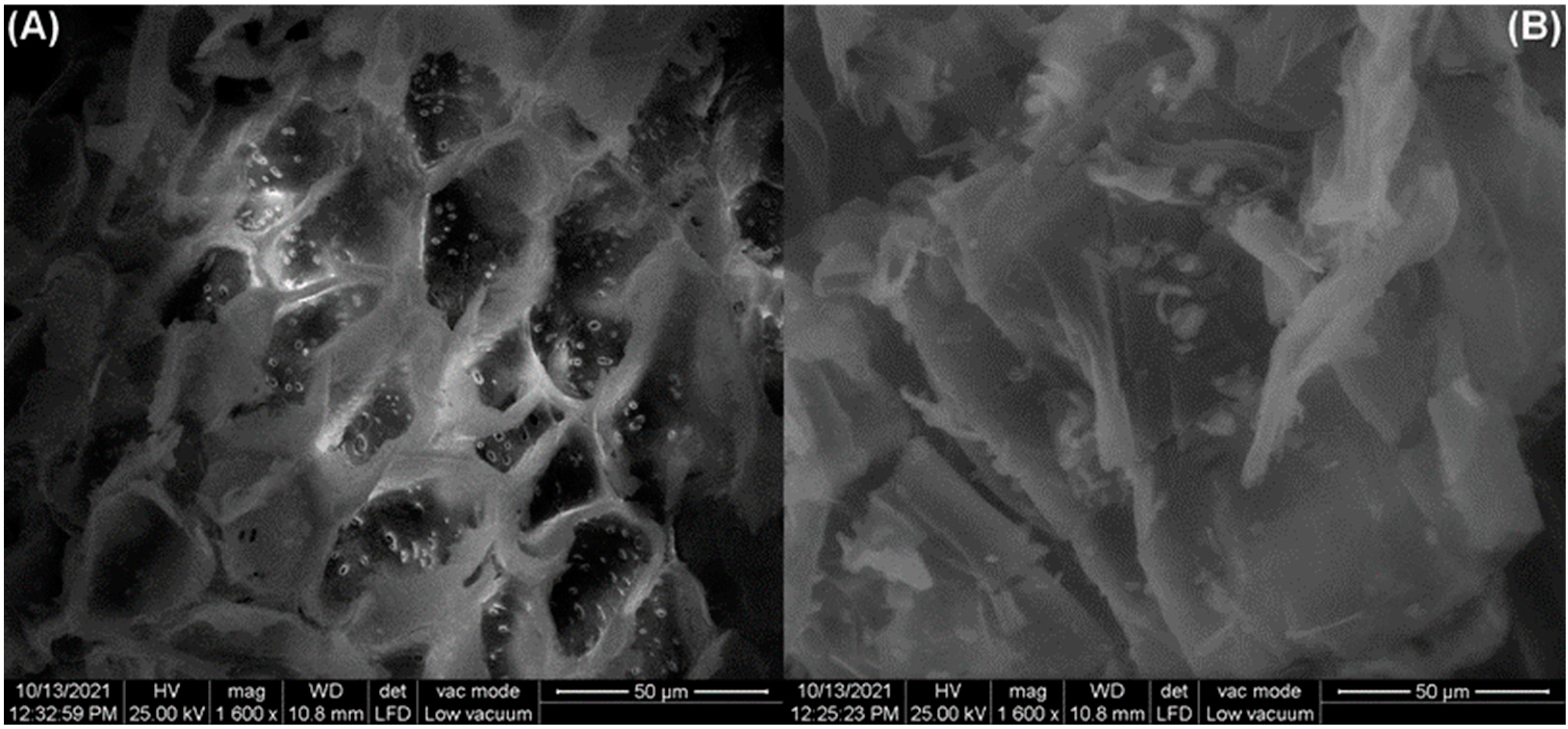
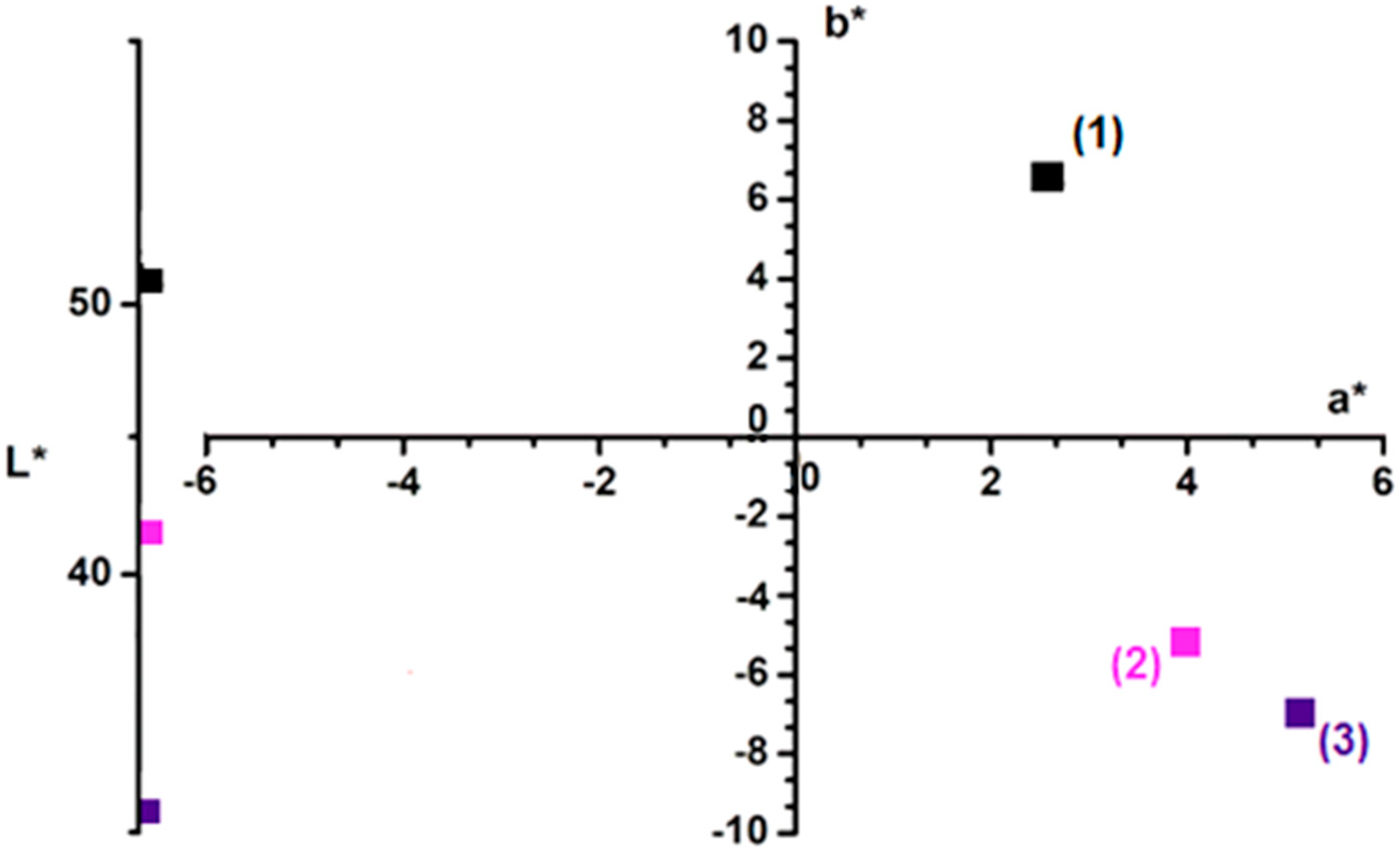
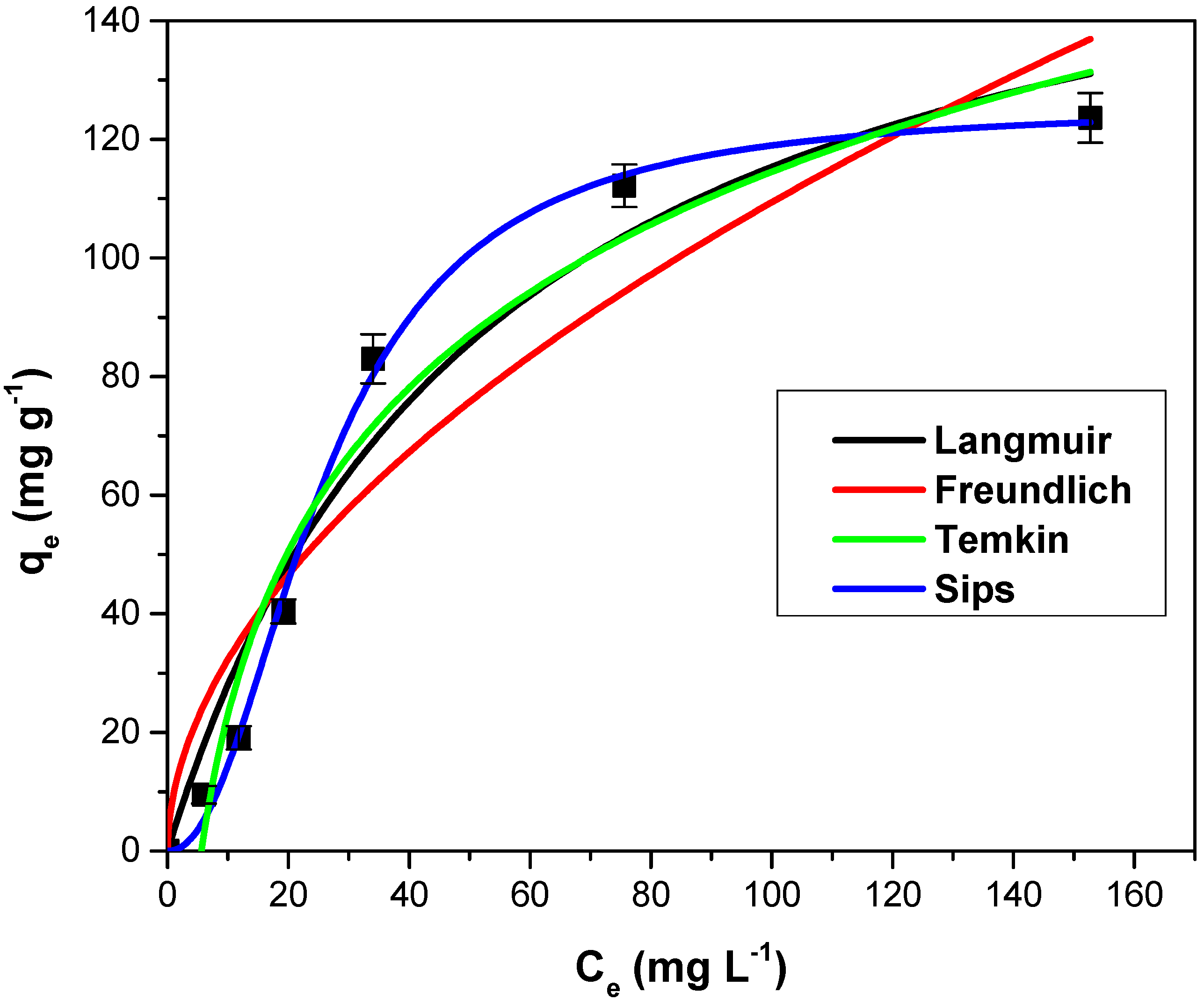
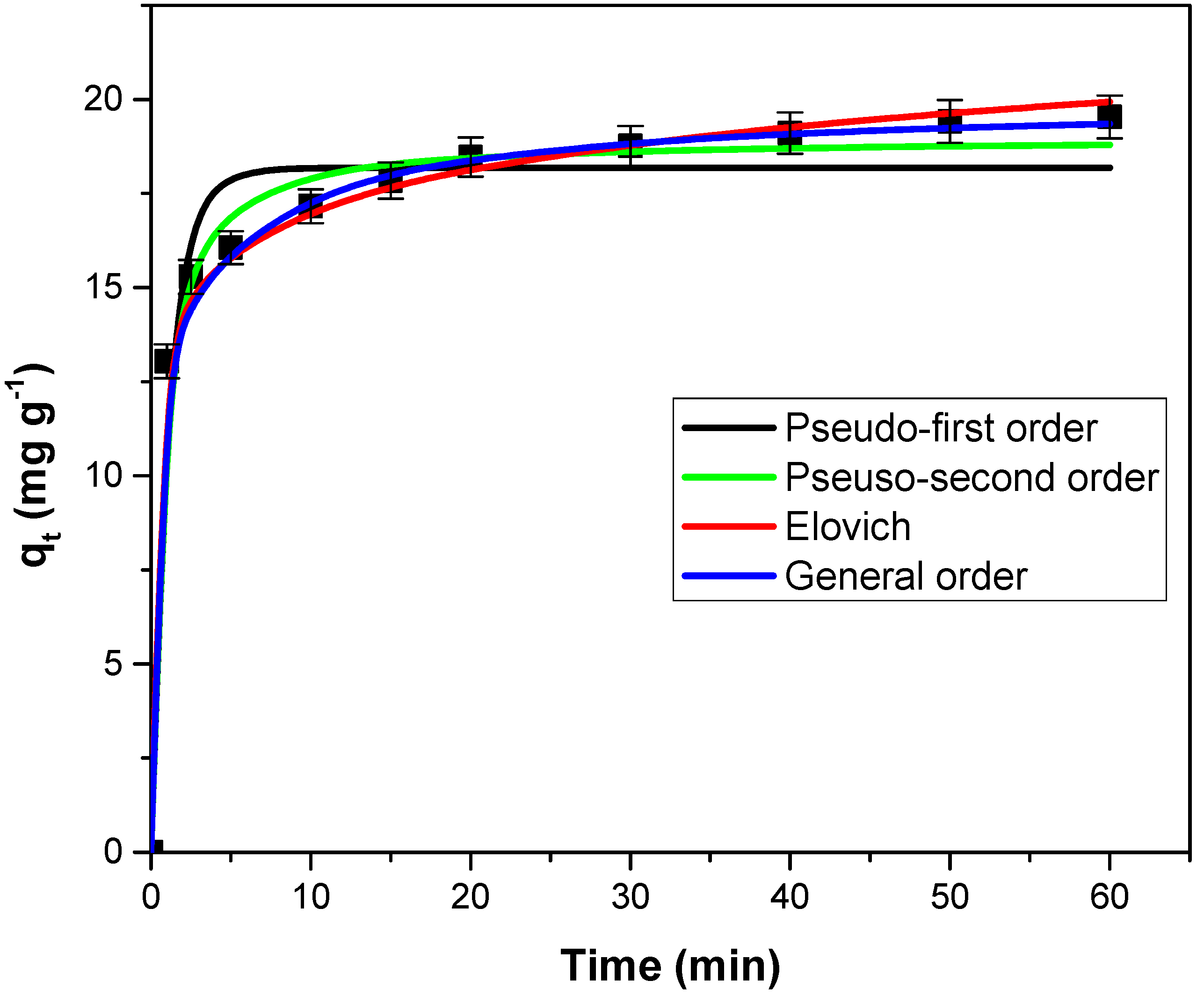
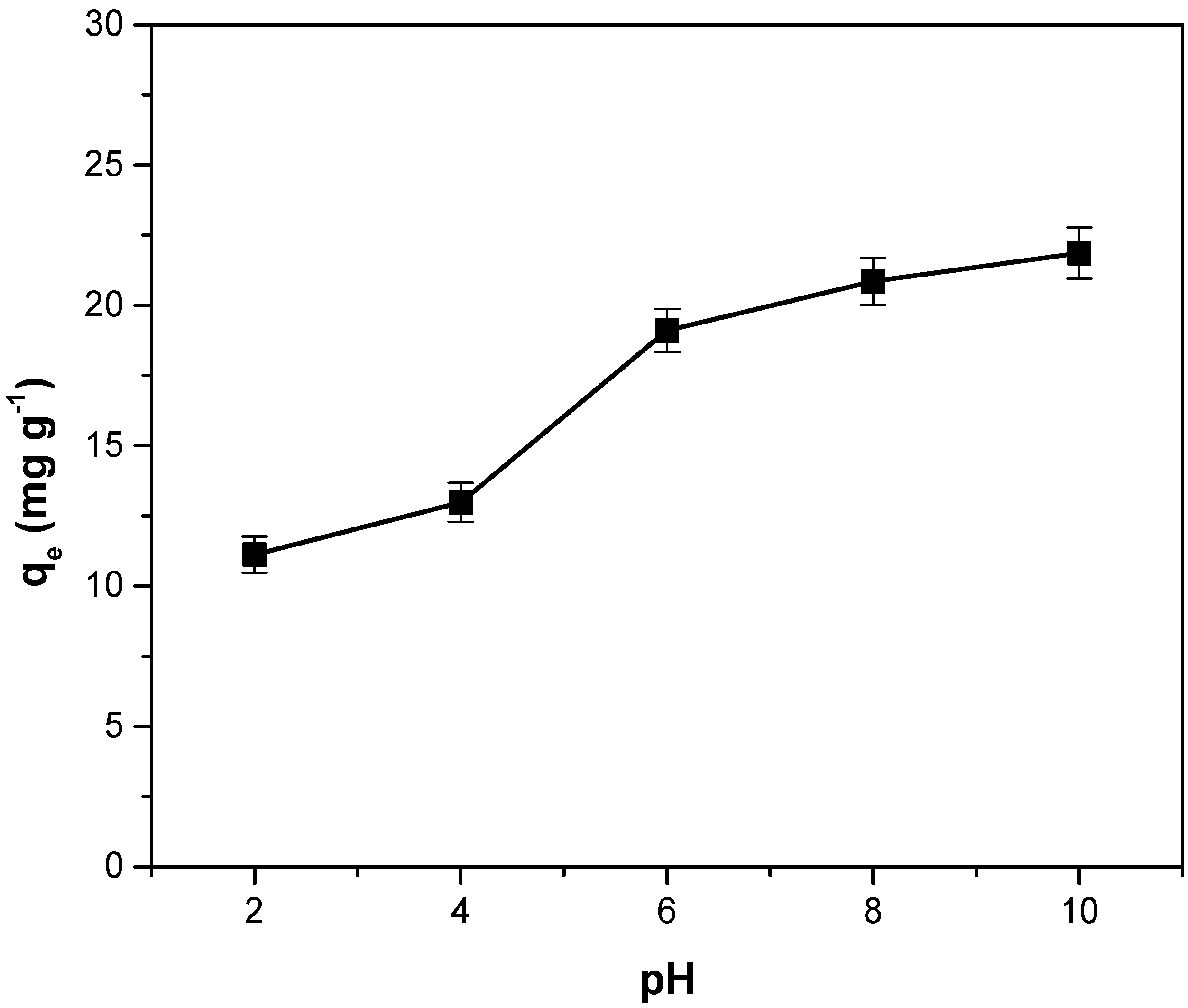


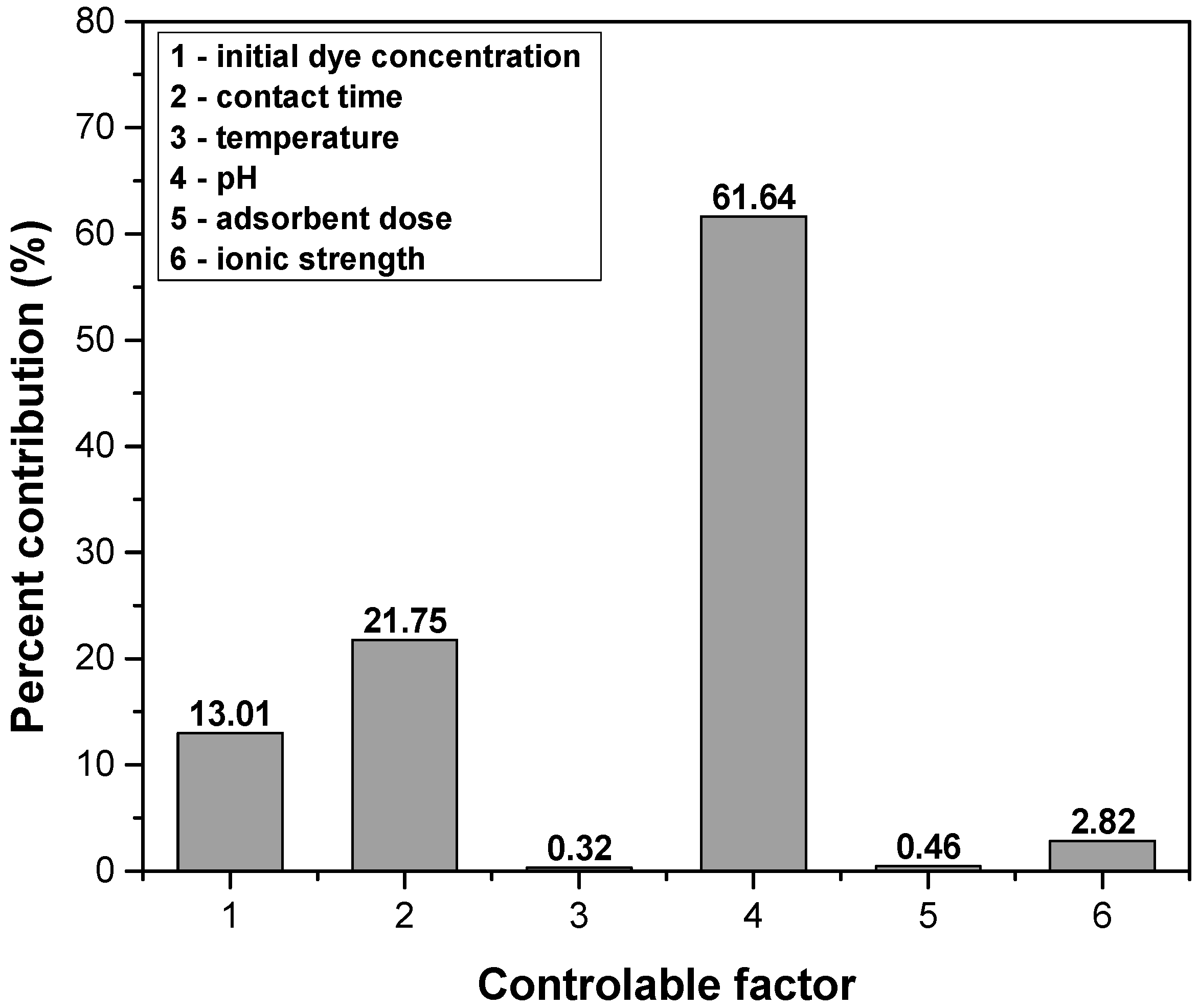
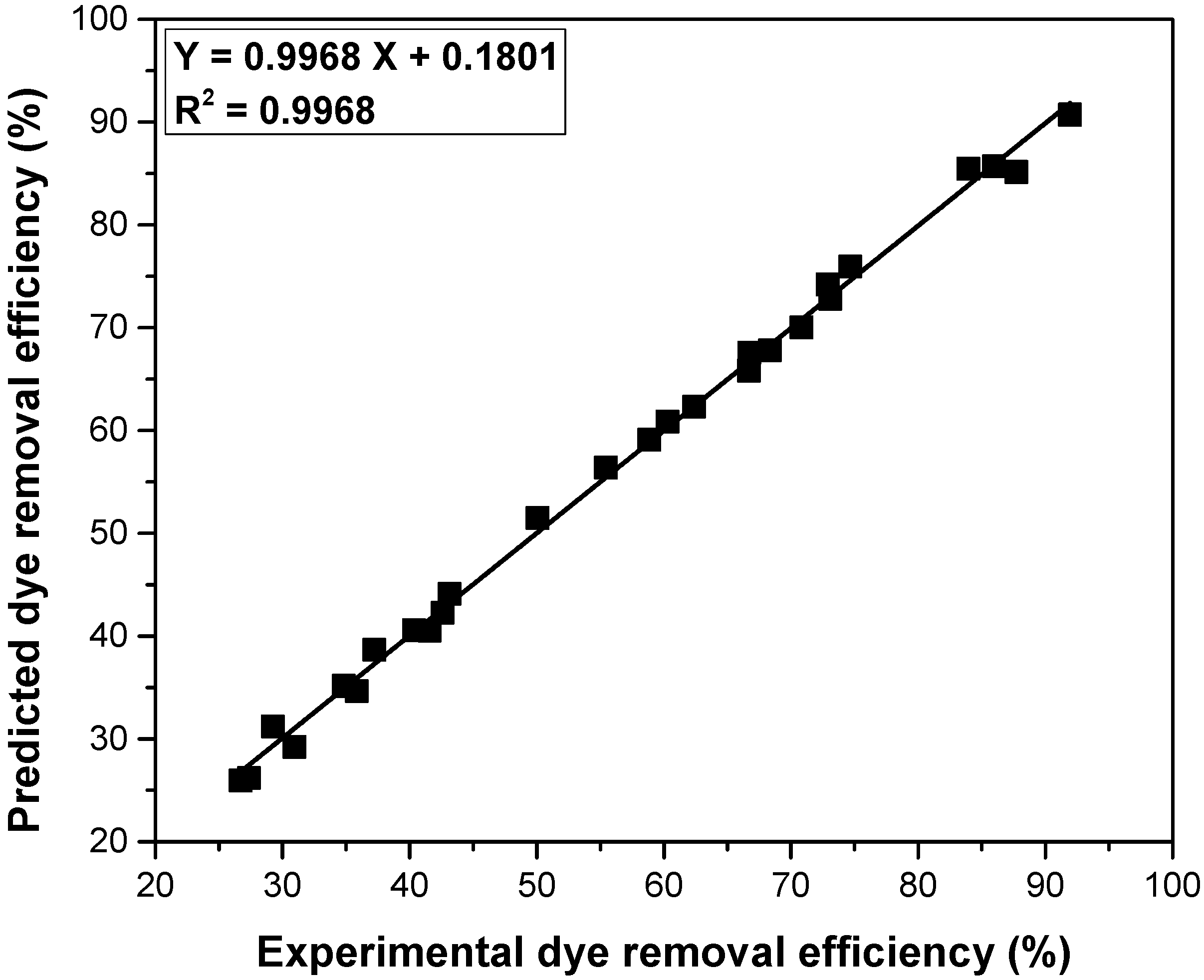
| Isotherm Model | Parameters | Value |
|---|---|---|
| Langmuir | KL (L mg−1) | 0.018 ± 0.001 |
| qmax (mg g−1) | 176.6 ± 4.75 | |
| R2 | 0.9646 | |
| χ2 | 14.17 | |
| SSE | 607.2 | |
| ARE (%) | 22.63 | |
| Freundlich | Kf (mg g−1) | 9.51 ± 1.43 |
| 1/n | 1.88 ± 0.25 | |
| R2 | 0.9075 | |
| χ2 | 29.32 | |
| SSE | 1465 | |
| ARE (%) | 30.29 | |
| Temkin | KT (L mg−1) | 0.17 ± 0.05 |
| b (kJ g−1) | 61.46 ± 3.24 | |
| R2 | 0.9681 | |
| χ2 | 22.81 | |
| SSE | 489.2 | |
| ARE (%) | 51.09 | |
| Sips | Qsat (mg g−1) | 125.6 ± 5.34 |
| KS (L mg−1) | 0.003 ± 0.001 | |
| n | 2.14 | |
| R2 | 0.9978 | |
| χ2 | 3.64 | |
| SSE | 35.36 | |
| ARE (%) | 15.57 |
| Adsorbent | Maximum Adsorption Capacity (mg g−1) | Reference |
|---|---|---|
| Calotropis procera leaf | 4.14 | [44] |
| Calligonum comosum leaf | 5.00 | [45] |
| corn stalk | 9.64 | [46] |
| anatolian black pine | 12.36 | [47] |
| cedar cones | 13.64 | [4] |
| Lysiloma Latisiliquum seed | 14.14 | [48] |
| Salvinia natans powder | 12.74 | [49] |
| Arundo donax L. | 19.60 | [50] |
| Platanus orientalis leaf | 25.88 | [51] |
| pinus bark powder | 32.78 | [52] |
| peel of Cucumis sativa fruit | 34.24 | [53] |
| date palm leaves powder | 37.73 | [54] |
| Syzygium cumini leaves | 38.75 | [55] |
| jackfruit leaf powder | 43.39 | [56] |
| Eragrostis plana nees | 60.10 | [34] |
| coir pith | 65.53 | [57] |
| Laminaria japonica | 66.64 | [58] |
| pineapple leaf powder | 78.22 | [11] |
| papaya seeds powder | 85.99 | [25] |
| motherwort biomass | 125.6 | This study |
| breadfruit skin | 145.80 | [59] |
| Moringa oleifera pod husk | 156.25 | [23] |
| water hyacinth root powder | 322.58 | [24] |
| Kinetic Model | Parameters | Values |
|---|---|---|
| Pseudo-first order | k1 (min−1) | 1.091 ± 0.023 |
| qe,calc (mg g−1) | 18.18 ± 0.71 | |
| R2 | 0.9566 | |
| χ2 | 0.79 | |
| SSE | 13.78 | |
| ARE (%) | 14.61 | |
| Pseudo-second order | k2 (min−1) | 0.097 ± 0.004 |
| qe,calc (g mg−1 min−1) | 18.95 ± 0.74 | |
| R2 | 0.9880 | |
| χ2 | 0.22 | |
| SSE | 3.78 | |
| ARE (%) | 3.15 | |
| Elovich | a (g mg−1) | 0.617 ± 0.081 |
| b (mg g−1 min−1) | 5982 ± 253 | |
| R2 | 0.9973 | |
| χ2 | 0.55 | |
| SSE | 0.98 | |
| ARE (%) | 10.35 | |
| General order | kn (min−1 (g mg−1)n–1) | 0.0008 ± 0.0001 |
| qn (mg g−1) | 19.91± 0.46 | |
| n | 3.34 | |
| R2 | 0.9979 | |
| χ2 | 0.04 | |
| SSE | 0.69 | |
| ARE (%) | 0.94 |
| ΔG0 (kJ mol−1) | ΔH0 (kJ mol−1) | ΔS0 (J mol−1 K−1) | ||
|---|---|---|---|---|
| 282 K | 293 K | 307 K | ||
| −20.94 | −21.79 | −22.86 | 0.074 | 9.19 |
| Factor | Level 1 | Level 2 | Level 3 |
|---|---|---|---|
| Initial dye concentration (mg L−1) | 25 | 200 | 400 |
| Time (min) | 1 | 30 | 60 |
| Temperature (K) | 282 | 293 | 307 |
| pH | 2 | 6 | 10 |
| Adsorbent dose (mg L−1) | 1 | 3 | 6 |
| Ionic strength (mol L−1) | 0 | 0.10 | 0.25 |
| Initial Dye Concentration | Time | Temperature | pH | Adsorbent Dose | Ionic Strength | Removal Efficiency | S/N Ratio |
|---|---|---|---|---|---|---|---|
| 25 | 1 | 282 | 2 | 1 | 0 | 29.26 | 29.32 |
| 25 | 1 | 282 | 2 | 3 | 0.1 | 27.36 | 28.74 |
| 25 | 1 | 282 | 2 | 6 | 0.25 | 26.72 | 28.53 |
| 25 | 30 | 293 | 6 | 1 | 0 | 73.08 | 37.27 |
| 25 | 30 | 293 | 6 | 3 | 0.1 | 68.34 | 36.69 |
| 25 | 30 | 293 | 6 | 6 | 0.25 | 66.74 | 36.48 |
| 25 | 60 | 307 | 10 | 1 | 0 | 91.94 | 39.27 |
| 25 | 60 | 307 | 10 | 3 | 0.1 | 85.97 | 38.68 |
| 25 | 60 | 307 | 10 | 6 | 0.25 | 83.96 | 38.48 |
| 200 | 1 | 293 | 10 | 1 | 0.1 | 60.28 | 35.60 |
| 200 | 1 | 293 | 10 | 3 | 0.25 | 58.85 | 35.39 |
| 200 | 1 | 293 | 10 | 6 | 0 | 70.83 | 37.00 |
| 200 | 30 | 307 | 2 | 1 | 0.1 | 42.61 | 32.59 |
| 200 | 30 | 307 | 2 | 3 | 0.25 | 41.6 | 32.38 |
| 200 | 30 | 307 | 2 | 6 | 0 | 50.07 | 33.99 |
| 200 | 60 | 282 | 6 | 1 | 0.1 | 74.66 | 37.46 |
| 200 | 60 | 282 | 6 | 3 | 0.25 | 72.89 | 37.25 |
| 200 | 60 | 282 | 6 | 6 | 0 | 87.72 | 38.86 |
| 400 | 1 | 307 | 6 | 1 | 0.25 | 35.85 | 31.08 |
| 400 | 1 | 307 | 6 | 3 | 0 | 43.13 | 32.69 |
| 400 | 1 | 307 | 6 | 6 | 0.1 | 40.35 | 32.11 |
| 400 | 30 | 282 | 10 | 1 | 0.25 | 55.44 | 34.87 |
| 400 | 30 | 282 | 10 | 3 | 0 | 66.7 | 36.48 |
| 400 | 30 | 282 | 10 | 6 | 0.1 | 62.39 | 35.90 |
| 400 | 60 | 293 | 2 | 1 | 0.25 | 30.95 | 29.81 |
| 400 | 60 | 293 | 2 | 3 | 0 | 37.24 | 31.42 |
| 400 | 60 | 293 | 2 | 6 | 0.1 | 34.83 | 30.83 |
| Level | Initial Dye Concentration | Time | Temperature | pH | Adsorbent Dose | Ionic Strength |
|---|---|---|---|---|---|---|
| 1 | 34.83 | 32.28 | 34.16 | 30.85 | 34.15 | 35.15 |
| 2 | 35.62 | 35.19 | 34.50 | 35.55 | 34.42 | 34.29 |
| 3 | 32.80 | 35.79 | 34.59 | 36.86 | 34.69 | 33.81 |
| Delta | 2.81 | 3.51 | 0.43 | 6.01 | 0.55 | 1.33 |
| Rank | 3 | 2 | 6 | 1 | 5 | 4 |
Publisher’s Note: MDPI stays neutral with regard to jurisdictional claims in published maps and institutional affiliations. |
© 2022 by the authors. Licensee MDPI, Basel, Switzerland. This article is an open access article distributed under the terms and conditions of the Creative Commons Attribution (CC BY) license (https://creativecommons.org/licenses/by/4.0/).
Share and Cite
Mosoarca, G.; Vancea, C.; Popa, S.; Dan, M.; Boran, S. Crystal Violet Adsorption on Eco-Friendly Lignocellulosic Material Obtained from Motherwort (Leonurus cardiaca L.) Biomass. Polymers 2022, 14, 3825. https://doi.org/10.3390/polym14183825
Mosoarca G, Vancea C, Popa S, Dan M, Boran S. Crystal Violet Adsorption on Eco-Friendly Lignocellulosic Material Obtained from Motherwort (Leonurus cardiaca L.) Biomass. Polymers. 2022; 14(18):3825. https://doi.org/10.3390/polym14183825
Chicago/Turabian StyleMosoarca, Giannin, Cosmin Vancea, Simona Popa, Mircea Dan, and Sorina Boran. 2022. "Crystal Violet Adsorption on Eco-Friendly Lignocellulosic Material Obtained from Motherwort (Leonurus cardiaca L.) Biomass" Polymers 14, no. 18: 3825. https://doi.org/10.3390/polym14183825
APA StyleMosoarca, G., Vancea, C., Popa, S., Dan, M., & Boran, S. (2022). Crystal Violet Adsorption on Eco-Friendly Lignocellulosic Material Obtained from Motherwort (Leonurus cardiaca L.) Biomass. Polymers, 14(18), 3825. https://doi.org/10.3390/polym14183825










